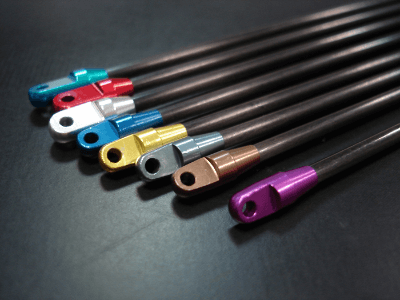What Is Colored Anodized Aluminum?
 Color anodized aluminum is an oxide film produced on the surface of aluminum by electrolytic treatment and colored by penetrating dye.
Color anodized aluminum is an oxide film produced on the surface of aluminum by electrolytic treatment and colored by penetrating dye.
Anodizing is a technology that increases rust resistance by generating an artificial oxide film on the surface of aluminum and is characterized by its resistance to rust compared with solid aluminum. However, since anodized aluminum itself is colorless and transparent, colored anodizing requires a special technique.
Color anodized aluminum is colored by opening pores of about 10 μm in diameter in the oxide film produced by anodizing and allowing dye to permeate through them. Then, after the dye is absorbed, the pores are sealed, making it difficult for the dye to peel off and improving durability. Adding color to aluminum products not only improves their appearance but also improves wear and corrosion resistance.
Uses of Color Anodized Aluminum
Color anodized aluminum is unique in that it can change the color of an aluminum product. Furthermore, aluminum is widely used in every day and industrial products because it is lightweight and rust-resistant. It not only extends the life of products, but also contributes to improved design through color.
Specific applications include lunch boxes, kettles, pots, and computer frames. It is widely used for a variety of everyday products as well as industrial products, such as sports equipment and bicycle frames. Color anodized aluminum can change the appearance of a product, thereby enhancing its brand image and added value.
Color anodized aluminum can be colored in green, red, pink, blue, gold, or black, depending on the anodizer. By combining colors or creating patterns with different colors, a wider variety of design possibilities can be realized. It is one of the indispensable technologies for product manufacturing because it combines functionality and design.
Principle of Color Anodized Aluminum
Color anodizing may not work well if the amount of silicon or copper contained in the aluminum is too high. Typical aluminum die-cast products (e.g., ADC12) contain high levels of silicon and copper, which can cause the color to become lighter or the black color to turn gray.
Care should be taken when coloring, as this can detract from the product’s attractiveness as a decorative item. In plating, metal ions in an electrolytic solution are reduced and deposited to form a metal plating on the surface of the object. Anodizing, on the other hand, dissolves the surface of aluminum with acid to form a film.
The film consists of a permeation film and a growth film. When specifying the film thickness, the amount of raising is less than that of plating, because the film is formed only by the dissolved amount.
Types of Color Anodized Aluminum
Color anodized aluminum can be broadly classified into three types: single-color anodized aluminum, two-color anodized aluminum, and bright anodized aluminum. It is important to select the type of colored anodized aluminum that best suits the application.
Different shades and textures can be expressed depending on the thickness of the coating and the coloring method, resulting in products with excellent design characteristics.
1. Monochromatic Anodizing
Monochromatic aluminum is an anodized aluminum coating with only one color, mainly black, blue, red, or green. It is used to express a unified color tone, as the basic color tones are all available.
2. Two-Color Anodizing
Two-color anodizing consists of alternating layers of two different anodized aluminum coatings, typically black and red, blue and red, green and blue, etc. Compared to monochromatic anodizing, two-color anodizing can express more unique tints, making it possible to create anodized aluminum coatings with excellent design characteristics.
3. Glossy Anodized Aluminum
Glossy anodizing is characterized by its high luster finish and metallic texture. Mainly used for silver, gold, and brass, it can produce a sense of high quality.